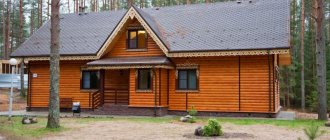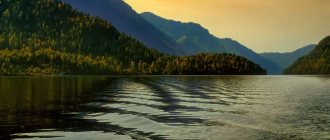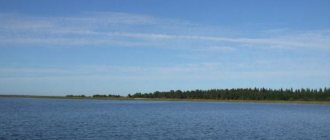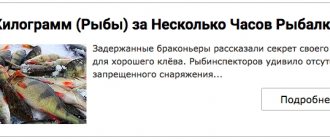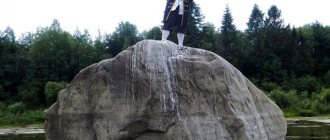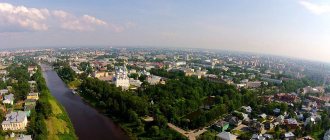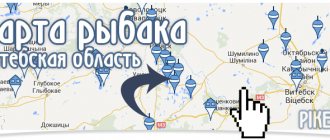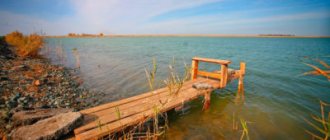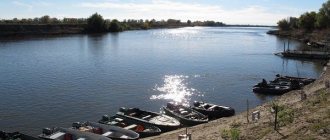Fishing in the Vologda region is attractive due to the abundance of large rivers, huge lakes, reservoirs and the absence of strong fishing pressure on reservoirs.
- Where to go Rivers
- Lakes
- Reservoirs
The Vologda region is enormous, and fishermen have their own treasured spots. In places where there are no villages near water bodies, there are practically no fishermen. Of course, there is Akhtuba and there is Karelia, but the significance of these places is not in doubt.
Where to go fishing in the Vologda region
The largest fishing rivers in the Vologda region: Sukhona, Mologa, Yug, Sheksna. Among the large lakes we can highlight: Beloe, Vozhe, Onega, Kubenskoye. They are also caught in two reservoirs - Rybinsk and Sheksninsky.
Fishing in the Vologda region
Both summer and winter fishing are developed in the Vologda region - the ice lasts here from November to April. Fishing on lakes is more popular in winter. People come here for pike perch, pike, perch, and catfish. Some fishermen bring burbot and grayling.
Rivers
Ukhtomka River. A small river, only 20 km long. The river originates in the forests and flows into the Northern Dvina. In general, fishing here is no different from fishing in any other river, except that this small river is quite remote from populated areas and flows in the ecologically clean zone of the Veliky Ustyug region of the region.
Suda River. A river with a varied selection of fish. A dam was recently built near the village of Kaduy. Above the dam the current is less and trout can be caught there. Downstream there are pike perch, bluefish, and bersh.
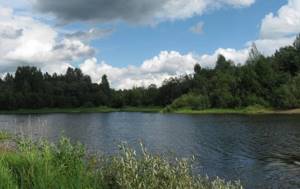
Suda River
A state district power plant is located closer to the confluence with the Rybinsk Reservoir. There, warm water runoff created favorable conditions for fish farms.
Mologa River. This is a major tributary of the Volga. The name of the river is translated from Finno-Ugric as “fish river”. The ideal time for fishing is spring. At this time, bream, ide, pike and pike perch move upstream. There are grayling in the river, but catching one is very rare.
Sukhona River. This is the largest river in the Vologda region. It is better to fish in the lower reaches of the river. Pike, ide, roach, bream and perch are found here.
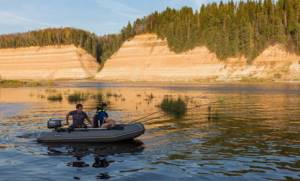
Sukhona River
The river is rich in ide population. It is better to fish where there are underwater piles of petrified clay, as well as near rocky shores. It is best to fish with a donk.
Lakes
Lake Kubenskoye. 30 kilometers from Vologda there is a large lake Kubenskoye. The reservoir attracts not only its proximity to the regional center, but also excellent fishing.
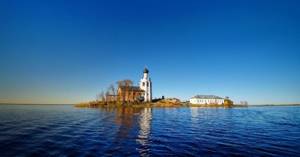
Lake Kubenskoye
There are large fish in the lake. You can catch dace, bream, perch, pike, burbot, etc.
Lake Beloe. Fishing on White Lake is popular among anglers who want excitement and dynamics. Once you get onto the perch boiler, you will become a “hostage” of the lake.
Fishing on the lake is chosen by people who need to relax and are guaranteed to feel the bite.
Lake Vozhe. Large and shallow lake. The area of the lake is more than 400 square meters. km. The average depth ranges from 2 to 5 meters.
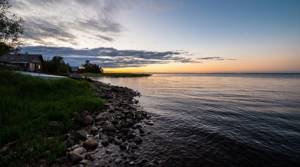
Lake Vozhe
Lake Vozhe is ideal for catching bleak. To do this, you will have to arm yourself with a float with a good sinker and small hooks. Bleak can be caught everywhere, the optimal places being near the mouths of small streams.
Lake Ezhezero. On the shore of the lake there is a small guest town for visiting lovers of outdoor recreation. The reservoir is traditionally preferred by winter fishing enthusiasts.
The lake is located far from civilization. In the winter silence it is very pleasant to fish here.
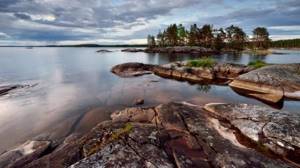
Lake Onega
Lake Onega. The second largest lake in Europe. The water here is cleaner than other lakes, since there are no large cities nearby. The legendary Onega salmon lives here.
Reservoirs
Rybinsk Reservoir. Fishing here is possible at any time of the year. The versatility of the reservoir and its proximity to Vologda attracts many fishermen here.

Rybinsk Reservoir
Here you can catch traditional pike and pike perch, and there are roach, bream and burbot. Winter season is from November to April. In the summer they usually catch pike perch. The easiest time to catch big fish is in the fall.
Sheksna Reservoir. The reservoir is formed by a hydroelectric dam. There is a lot of fish here, including catfish, pike, and bream.
Local fishermen fish from the shore, but you can also fish from a boat. There are many rental boat stations on the shore.
Traveling around the Vologda region
We are publishing an article kindly provided by Anton Dombrovsky, a well-known fly fisherman in Moscow and a specialist in grayling fishing. He talks about fishing trips to the Vologda region. Why and why is the Vologda region in the Ukrainian magazine?
It’s very simple: we want to tell our fishermen who go fishing to Russia - to the Lower Volga, to the Kola Peninsula, to Karelia - that the choice of interesting places is not limited to this popular set, you can find many quiet corners where it is still possible to go fishing in peace, not bumping shoulders with other anglers. And for this you don’t need to fly to Kamchatka, such places still exist in relative proximity to us... Naturally, there is no service there, which many of our fishermen are already accustomed to - a room with private amenities, a bar, a refrigerator stocked with drinks, service staff, a huntsman who will take out to the point and will show you where to throw... But here you need to choose - where all these benefits of civilization appear, it is no longer possible to communicate with nature in solitude... Fly fishing involves constant movement along rivers - as in search of active, and often larger fish, and for the purpose of better understanding the river. In general, I prefer to constantly explore something new than to sit in one, more or less well-known place. As a rule, a trip begins with a thorough study of the map of the area - even in winter, long before the trip. But, unfortunately, the available maps are not very informative.
At best, they show the levels of water fall in the river, and one can only guess about the location of the rifts and rapids in its individual sections. Often the data marked on the maps does not correspond to what actually exists on the ground. So you need to treat the cards with a certain amount of skepticism. Although, water level marks can help roughly determine the location of riffles or rapids. If on the map at a distance of five kilometers the river flow has a difference of three meters or more, then believe me, in this section at least there is a powerful riffle. And a river drop of a meter per kilometer or more indicates the presence of rapids or long-lasting turbulent rifts. Having found such a place on the map, all that remains is to come there and, walking along the river, make sure that the conclusions drawn earlier on the map are correct. Yes! A great help in more accurately determining the rifts and rapids on the river can be provided by visiting the sites of water tourists.
There is location-specific information about the presence of such on the selected river. Unfortunately, information about not all rivers of interest to anglers is available on these sites. Apparently, not all rivers that are interesting from a fishing point of view are interesting for water tourists. But for the seeking fly fisherman, small and little-known rivers can provide many unforgettable hours of fishing. And decent trophies too. So, information about rivers has to be obtained by visiting them in person, spending your weekends and vacations on trips. However, these reconnaissance trips are not always successful. As a rule, one trip out of many is completed successfully. Pike, perch and other fish are found in many rivers in greater or lesser quantities, but finding the habitats of grayling or trout is a rather difficult task. The Tver and Novgorod regions have been more or less studied; Both trout and harjus rivers are mostly already known. But there is practically no information on the rivers of the Vologda region. Although many interesting rivers and streams flow through the territory of the Vologda region. I previously managed to visit and fish on the rivers of the west and southwest of the Vologda region. This year, my friends and I managed to go exploring in the north of the region for the weekend. Our route ran along the Arkhangelsk highway.
The plans included visiting three, in my opinion, very interesting rivers - Vaga, Kuloi and Syamzhena. We were on all three of these rivers. The purpose of the trip was to scout for the presence of grayling in them. Looking ahead, I will say that grayling is found in all three rivers. So, I think the trip was a success, although no trophy specimens were caught. First of all, we went to the upper reaches of the Vaga River. We arrived at the bridge marked on the map and were surprised - but there was no bridge! More precisely - there is, but unfinished. Apparently, during the times of developed socialism, they cut a direct clearing to the highway, laid out a fairly decent dirt road, and it became a matter of the bridge over the Vaga. Most likely, they planned to transport timber to the highway along this road. So, piles were driven into the ground, beams and logs were brought in for construction, for the next anniversary of the revolution they reported on the commissioning of the bridge and road and forgot to complete it. So everything was left lying on the shore. The locals are now fording the river. In the upper reaches the river is not very wide, beautiful, but for some reason water was not brought into it. It murmurs to itself in clear waters between stones and pebbles - in the deepest place the water is knee-deep. There are a lot of little things the size of a little finger, but no big fish are visible. The summer was hot and dry, there was no rain for two months, and this affected the water level in the river.
Apparently, the larger fish moved downstream in search of more acceptable conditions. Disappointed, we went to look for better places. I was especially struck by the beauty of the Kuloy River, which originates in Lake San-Duzhskoe. These places are sparsely populated and difficult to access. We decided to drive up to the river through the regional center of Verkhovazhye, which stands on another river called Vaga, to the village of Rogna - a God-forsaken village of lumberjacks located on the banks of the Kuloy. The road leading to Rog-ne is a fairly decent quality one, laid through the taiga. But further, to the village of Orinodory, there is practically no road, in the understanding of a normal city dweller, or rather, there is a dirty mess, along which it is best to move on a tractor or a charged jeep. Our trip, of course, was not without adventure. Due to the deplorable state of the road (or rather, the direction), we had to get the car out of that mess within an hour and a half, which I very boldly called the road. We drove up the river as far as we could, left the car, changed clothes and continued on foot. As I already said, the summer was hot and dry. Due to this, the water level in the rivers was low, the water was very warm, and fishing was poor. Most likely, the main herd of grayling moved to the lower reaches of the river, where conditions were better. I was also struck by the huge number of fairly large dace in these rivers. The places are fabulously beautiful. Fishing on this river was best on a dry fly tied parachute style. I had to walk quite a bit. Most of the time, of course, was taken up by moving from one river to another, leaving little time for food and sleep. I wanted to see as many new places on the rivers as possible and explore the routes to them. It was the hardest for Andrey, who was constantly driving the car. This is how the reconnaissance turned out. We will assume that it was a success, and that means we can make plans for future trips with the goal of further development of these rivers. And on the map there are still other, unexplored corners beckoning... Time passed, and again a trip to the Vologda region. Now the route is different, our goal is the Kema River. My friend and I learned that there were grayling in this river quite by accident. During our next vacation, we decided to scout the rivers of the western part of the Vologda region for the presence of trout and grayling in them. At six o'clock in the morning the road took us to the river bank. There were ninety-five kilometers left to travel to the point marked on the map, and seven hundred and thirty were left behind. We, of course, were tired and decided to rest and have a snack on the shore. But can a fisherman sit calmly on the banks of an unfamiliar and beautiful river?! We couldn't resist either. Chewing sandwiches as we walked and washing them down with lemonade, we began to hastily get out gear and equipment. Quickly changing clothes and collecting gear, we went down to the river. I set up a goldhead nymph of my own making, which I call a felt boot, and began fishing the dying streams at the end of a small riffle. The first one I came across was a small grayling almost right next to the shore. I, of course, let him go, but I was happy. After all, we had no idea that such wonderful fish were found in this river. Within two hours the two of us caught about twenty good fish. Then there was a week-long trip full of impressions along the rivers planned in advance. I will tell you about it separately. We decided to devote the last day of the trip to fishing in the river, on the banks of which we were simply relaxing. We drove up to the shore, undressed and went fishing. My friend went downstream, and I went upstream, to the beginning of the rapids. By the way! These rapids are not marked at all on the map. I started fishing with a goldhead fly, casting upstream. Mostly small fish were caught. I slowly fished all the places I liked and climbed to the beginning of the rapid. There were a lot of bites - there was never a dull moment. So gradually I approached the place where the reach smoothly turns into a threshold. The depth of the reach is about one and a half to two meters, there are large stones at the bottom, and you often come across submerged logs. In the reach the current is slow, but as you approach the threshold it intensifies. Where the depth begins to decrease and turn into a shallower threshold, I noticed the emergence of large fish. More precisely, I noticed a couple of large bubbles on the surface left by the fish at the moment when it picked up a newly hatched mayfly from the surface, which was drying its wings. Of course, it would be right to change the nymph to a dry fly and continue fishing, but passion and, perhaps, reluctance to change anything became compelling arguments, and I continued fishing with a nymph... And I was right! But everything is in order... I took a position slightly above where the fish came out and made the first cast upstream. The first retrieve, with holding the cord and simulating the surfacing of the nymph at the end of the retrieve, did not bring any results. I added about a meter of line and repeated the cast. At the end of the retrieve, when the nymph began to rise to the surface under the influence of the current, a neat bite followed. I hooked it. At first I didn’t understand what size the fish was on my hook. My tackle was aimed at catching small fish; I didn’t even think that a large trophy could be found in this river. Or rather, a fifth-class fishing rod is quite a powerful weapon, but the leash was not very thick - 0.14 mm, and the fly was tied on a number 16 hook. The first candle that grayling made gave me a slight shock. He confidently swam towards the drain into the threshold, and the distinct prospect of being left without this fish loomed before me. The current in the drain was strong, and running along the shore was not a safe activity. I pressed the cord with my finger to the handle and decided - come what may! If I release this grayling into the seething drain of the rapids, I will probably lose it. If I hold the cord tightly, the leash may not hold. Fortunately, he survived, and I managed to turn the fish towards the reach. But the fight against grayling did not end there. He never thought of giving up so easily! There were two more spectacular candles, there was stubborn resistance in the current, when it seems that the fish cannot be moved from its place, it stands rooted to the spot. But in the end, the grayling gives up, and I bring it into the landing net. A beautiful specimen, 55 cm long. I put the fish in a basket and sit down on the shore to smoke. The day was a success! I’m glad, of course, but the thought arises: what if there’s another one like it standing here? After slowly smoking a cigarette, I go back into the river. I cast upstream, and lo and behold! - a bite follows! There is another grayling on the hook, slightly smaller than the previous one. Still, my intuition did not disappoint! I would also like to say something about intuition. There are moments in fishing when you approach a place on the river, it seems, you can’t see the fish, but you have the feeling that it’s definitely there; and she really gets caught. Perhaps not immediately, you have to change the depth, style of fishing, fly, but as a result you catch fish, and more than one. Your comrades often wonder how, given the relative lack of bite, you managed to catch anything? As a rule, in such situations, non-standard approaches to fishing come to the rescue. In general, I like fly fishing precisely because I constantly have to think, study, and compare. That is, constantly learn, accumulate knowledge, and this, you see, is the most interesting thing. But let's get back to fishing. Having caught the second grayling, I did not leave that place, but decided to make a few more casts. And my intuition did not let me down again. The third grayling pecked, a little smaller than the previous one, but still a decent size - 45 cm. That was the end of my fishing that day. Of course, I could still fish, but I no longer wanted to. I was completely satisfied with the result of the fishing and sat down on the shore to wait for my friend. Later we: Me, Sergey, Dima and Sasha, taking with us an inflatable motor boat, arranged a reconnaissance trip to the lower reaches of the river. Those places are difficult to access by road transport. The map shows five alternating rapids in that area. It was to them that our path lay. Unfortunately, the weather was not kind to us, and we only managed to walk ten kilometers downstream. But, nevertheless, the fish were caught very well. It’s a pity that we had to miss many promising places due to lack of time - after all, we had to go upstream before dark. There are a lot of driftwood logs in the river, which are located in the water in a very interesting way. The butt of the log, saturated with water, lies at the bottom, and the lighter top protrudes slightly above the surface, while the log is turned with the flow. When you go upstream on a motorboat, a collision with such a log is fraught with big problems. My comrades played the role of lookouts, and I was the helmsman. So, walking there under a motor in the dark is very unsafe. The return journey took two and a half hours, and we returned to the car in deep twilight. For several years now, I have been trying to get to this beautiful river at least once every year to fish, enjoy the river scenery, and spend an evening on the picturesque bank in the company of friends. I wish the same for you. Anton Dombrovsky Fisherman Pro No. 3 2009
Ban on fishing in the Vologda region
- from October 1 to April 30 - in wintering pits;
- from April 15 to June 1 - in the Rybinsk Reservoir within the administrative boundaries of the Vologda Region, with the exception of fishing with one float rod from the shore with no more than 2 hooks on fishing gear per citizen within the administrative boundaries of settlements outside spawning grounds;
- from April 25 to June 5 - pike perch, bream, pike, asp;
- from June 5 to July 5 - freshwater catfish;
- bream (residential form), pike perch (residential form) and pike: a) in all water bodies of fishery importance, with the exception of Lake Onega - from April 20 to June 10 ;
- b) in Lake Onega - from May 1 to June 10 ;
Where to set up camp, parking spots in the Ustya-Vologda area
Fishermen who prefer to be as close to nature as possible during multi-day fishing trips independently set up tent camps near the chosen fishing spot. Such stops during the period of active fish biting can be seen along the entire bank of the river near the village of Ustye-Vologodskoye.
Features of fishing in Ustye-Vologda
Most fishermen prefer to fish in this area from the shore using gear designed for long casting. The best place for wiring is considered to be the top of the riffle.
Trolling is also common. This method has a number of advantages and requires certain equipment. The best bait for this type of fishing is wobblers. They are available in white and green colors; you can also take other colors with a depth of up to 3 m.
A boat is rarely used for fishing on the unpredictable Sukhona - in the river, more effort is spent on steering the watercraft than on catching fish.
Fishing on the Sukhona lasts all year round, bream is especially successful in this, of which there is a huge amount in the reservoir. A good bite on the river is observed on calm, windless days. Maximum fish activity occurs in the early morning, before sunrise, and in the evening hours. At night it is possible to catch pike perch on a donk.
In cloudy weather, fish bite less often, especially ide. In autumn, when a rainy period of cooling sets in, it goes deeper, and bites occur very rarely.
Fishing on the Sukhona is an exciting and productive activity. With the right approach to the choice of gear and fishing location, even novice fishermen are not left without a decent catch.
Reservoirs of the region
Don’t forget about the reservoirs of the Vologda region. The fishiest of them are Sheksninskoye and Rybinskoye:
- Sheksna Reservoir. This reservoir is located on the Sheksna River. The reservoir was formed by a dam about 50 years ago. There is enough fish in it, catfish and pike live there. Local fishermen prefer fishing from the shore, but fishing from a boat is no less popular. There is even a boat rental station near the shore, so it is not necessary to bring a boat with you.
- Rybinsk Reservoir. This reservoir is considered one of the best fishing spots in Russia. In summer, pike perch is usually caught here, and pike in winter. Almost all types of fish (which live in the Russian Federation) live in large numbers in the reservoir. It is best to catch large fish in the fall, as at this time they go to the bottom and are easier to catch. Often there are specimens weighing ten or more kilograms.
Fish biting forecast on the Northern Dvina River
| Weather forecast and fish bite | Calendar, from 02/16/2021 to 02/19/2021 | |||||||||||
| VT | SR | Thu | PT | |||||||||
| Times of Day | Evening | Night | Morning | Day | Evening | Night | Morning | Day | Evening | Night | Morning | Day |
| Cloudiness, precipitation | Mainly cloudy | Partly cloudy | Clear | Partly cloudy | Clear | Clear | Partly cloudy | Mainly cloudy | light snow | Mainly cloudy | Partly cloudy | Clear |
| Temperature °C | -26 | -32 | -34 | -33 | -26 | -29 | -27 | -25 | -21 | -25 | -29 | -29 |
| Pressure, mm. | 765 | 767 | 768 | 768 | 768 | 768 | 767 | 764 | 763 | 765 | 767 | 768 |
| Direction, | North wind | North wind | North wind | North wind | Wind southwest | Wind southwest | Wind southwest | South wind | South wind | Wind southeast | East wind | Wind northeast |
| wind speed | 3 m/s | 2 m/s | 2 m/s | 1 m/s | 1 m/s | 2 m/s | 3 m/s | 4 m/s | 3 m/s | 2 m/s | 1 m/s | 1 m/s |
| According to the forecast, they will bite on: bloodworms crucian carp | 30% | 0% | 45% | 45% | 50% | 0% | 60% | 55% | 45% | 0% | 45% | 45% |
| According to the forecast, they will bite on: bloodworms Carp | 5% | 0% | 10% | 10% | 25% | 0% | 25% | 20% | 20% | 0% | 10% | 10% |
| According to the forecast, the fish will bite on: live bait (jigs), winter spinners, balancers Pike | 50% | 0% | 45% | 45% | 50% | 10% | 60% | 75% | 65% | 10% | 45% | 45% |
| According to the forecast, they will bite on: bloodworms, winter spoons, balance beams Perch | 40% | 0% | 55% | 55% | 60% | 0% | 70% | 65% | 55% | 0% | 55% | 55% |
| According to the forecast, they will bite on: bloodworms, maggots, bark beetles, burdocks Dace | 25% | 30% | 45% | 45% | 50% | 45% | 60% | 50% | 40% | 20% | 45% | 45% |
| According to the forecast, they will bite on: bloodworms, maggots, bark beetles, burdocks Ruff | 25% | 30% | 45% | 40% | 50% | 45% | 60% | 45% | 40% | 20% | 45% | 40% |
| According to the forecast, the fish will bite on: bloodworms, spoons, balance beams Trout | 20% | 0% | 50% | 35% | 50% | 0% | 70% | 45% | 40% | 0% | 50% | 35% |
| According to the forecast, they will bite on: bloodworms, maggots, bark beetles, burdocks Chub | 20% | 10% | 50% | 35% | 50% | 30% | 70% | 45% | 40% | 0% | 50% | 35% |
| According to the forecast, they will bite on: bloodworms, oparish, spinners Grayling | 20% | 0% | 50% | 35% | 50% | 0% | 70% | 45% | 40% | 0% | 50% | 35% |
| Bait: maggot, bloodworm Bream | 20% | 45% | 40% | 30% | 50% | 65% | 60% | 40% | 40% | 35% | 40% | 30% |
| Bait: worm, live bait, spinner Burbot | 60% | 50% | 40% | 10% | 60% | 70% | 60% | 50% | 80% | 70% | 40% | 10% |
| Bait: maggot, bloodworm Roach | 40% | 0% | 55% | 45% | 50% | 0% | 70% | 65% | 55% | 0% | 55% | 45% |
| Bait: maggot, bloodworm Bleak | 30% | 0% | 50% | 50% | 50% | 0% | 60% | 50% | 40% | 0% | 50% | 50% |
| Bait: maggot, bloodworm, bark beetle Ide | 10% | 0% | 30% | 20% | 40% | 0% | 50% | 30% | 30% | 0% | 30% | 20% |
